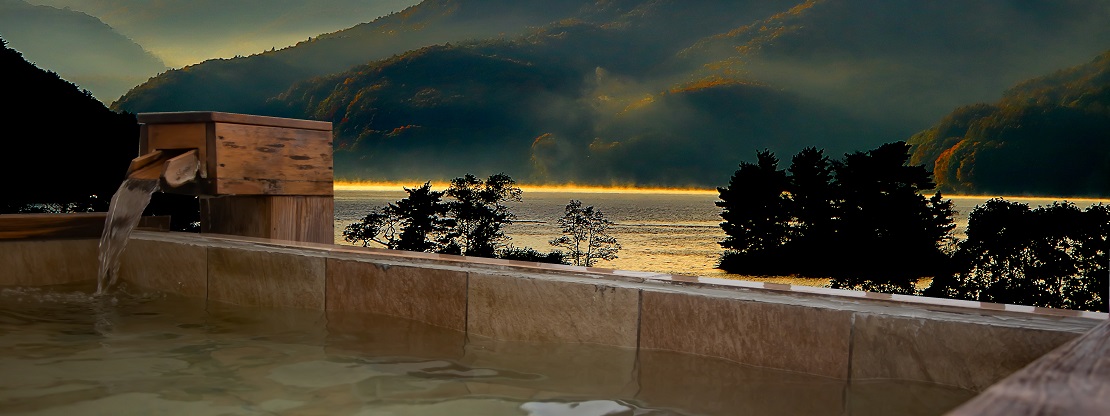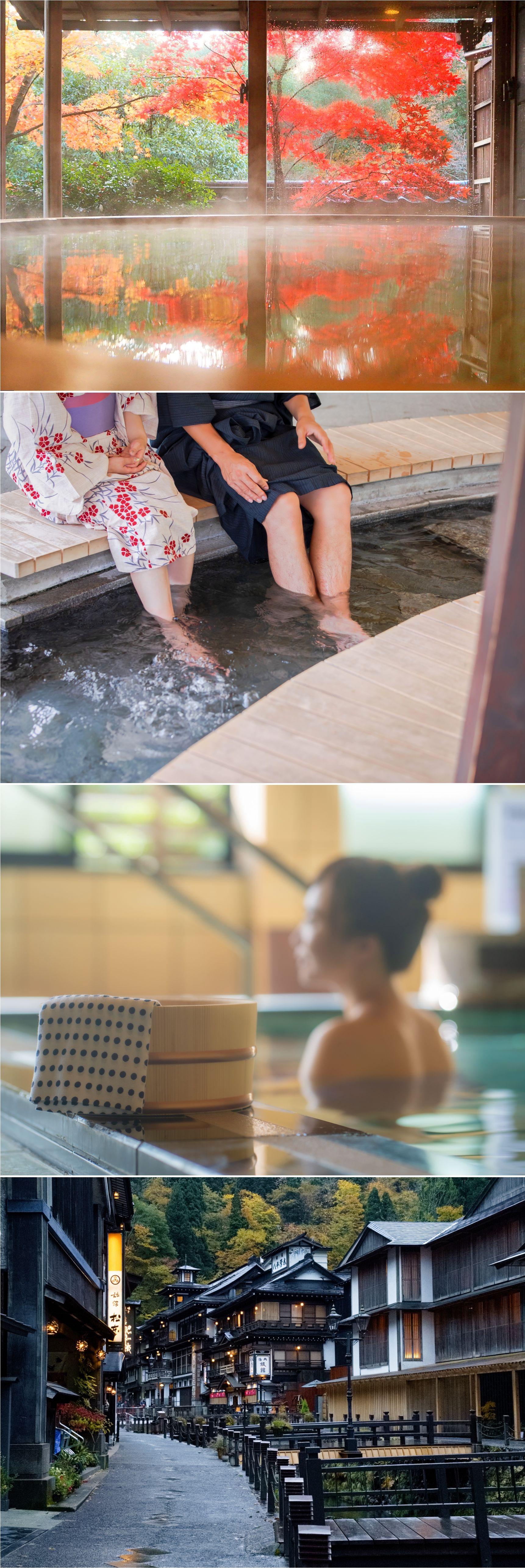-
- USA/Canada 1-800-285-2726
- Australia (02) 8006 4411

Featured Experience on our Group Japan Tours vacation packages.
Natural hot springs (onsen) are numerous and highly popular across Japan. Every region of the country has its share of hot springs and resort towns, which come with them. There are many types of hot springs, distinguished by the minerals dissolved in the water. Different minerals provide different health benefits, and all hot springs are supposed to have a relaxing effect on your body and mind. Hot spring baths come in many varieties, indoors and outdoors, gender separated and mixed, developed and undeveloped. Many hot spring baths belong to a ryokan, while others are public bath houses. An overnight stay at a hot spring ryokan is a highly recommended
experience for any traveler or vacation in Japan.
Below is a description of the most common way of taking a bath in a hot spring or public bath in Japan. The actual rules may differ slightly between baths, but if you follow the instructions below, you should be alright most of the time. Typical layout of a small indoor hot spring bath:
1: Take off all your clothes in the changing room and place them into a basket together with your bath towel. Coin lockers for valuables are often available.
2: Japanese hot springs are enjoyed naked. Swimming suits are not allowed in most places. However, it is the custom to bring a small towel into the bathing area, with which you can enhance your privacy while outside of the water. Once you enter the bath, keep the towel out of the water.
3: Before entering the bath rinse your body with water from either a tap or the bath using a washbowl provided in the bathing area. Traditionally, just rinsing your body is considered sufficient (and many older baths do not even provide showers and soap), but particularly among younger bathers you will find an increasing number of people who insist on taking a shower before entering the bath these days.
4: Enter the bath and soak for a while. Note that the bath water can be very hot (typical temperatures are 40 to 44 Celsius degrees or 104 to 111 Fahrenheit degrees). If it feels too hot, try to enter very slowly and move as little as possible.
5: After soaking for a while, get out of the bath and wash your body with soap at a water tap, while sitting on a stool. Soap and shampoo are provided in some baths. Like in private Japanese bathrooms, make sure that no soap gets into the bath water. Tidy up your space after you finished cleaning your body.
6: Re-enter the bath and soak some more. After you finished soaking, do not rinse your body with tap water, for the hot spring water's minerals to have full effect on your body.
For More information on how to enjoy a Japanese Hot-Springs, check out Japan Deluxe Tour's How to Properly use an Onsen Blog Post!

There are many types of hot springs to enjoy. The conventional hot spring is a hot water bath. Depending on the hot spring, different minerals are dissolved in the water, giving it different health benefits, colors and scents.
Hot spring water baths come indoors, outdoors and in many different sizes. Outdoor baths are called rotenburo. While some baths are wooden or stone tubs, others are built to resemble or are actually natural hot spring pools. Some outdoor baths are spectacularly situated in the mountains, valleys or along rivers, lake or sea shores.
Besides conventional hot water tubs, a popular feature of larger baths are so called waterfalls, which comfortably massage your shoulders if you sit below them. Other bath types include sand baths, where bathers are buried in naturally heated sand, mud baths and steam rooms.
Ashiyu are shallow hot spring pools for bathing just your feet. They are found in the streets of many hot spring resorts and can be used free of charge.
Increasing in number are modern hot spring complexes, which offer a range of baths, massage services, saunas and sometimes conventional swimming pools, water slides, etc. In Tokyo, where there is a shortage of natural hot spring water on the surface, some new hot spring complexes are retrieving their water from a depth of more than a kilometer below sea surface.
The ultimate hot spring experience is spending a night at an onsen ryokan, a Japanese style inn with hot spring baths. This is not only one of the most popular holiday activities among the Japanese, but is also highly recommended to any foreign visitor of Japan.
Onsen ryokan are found in various sizes in hot spring resorts across Japan. A typical onsen ryokan visit starts with a bath before dinner. The beautifully arranged Japanese style dinner, featuring local specialties, is either served in your tatami room or in a dining hall. Many guests like to take another bath before sleeping and before breakfast in the next morning.
You do not need to stay overnight at a ryokan in order to enjoy its baths. Many ryokan open their baths to the general public, typically during daytime only and against an admission fee of a few hundred yen. Besides ryokan, most hot spring resorts also have some public bath houses with hot spring water.
Hot springs in Japan are enjoyed naked, even though there are a few exceptions. While a majority of baths are gender separated, some are mixed. Mixed baths are usually found in more remote areas.
Furthermore, some establishments have both, gender separated and mixed sections, for example, in the case that there is just one spectacular outdoor bath, which the owner wants to make accessible to both genders.
For obvious reasons, many Japanese women, especially younger ones, avoid mixed hot springs, and it is not unusual that mixed pools are almost exclusively used by men.
If you do not feel comfortable naked in front of other people, you should inquire about "kashikiri" (private) baths, which are available at some ryokan. Private baths are sometimes also known as "kazokuburo", lit. family baths.
Tattoos are also a big issue when it comes to entering a public hot spring.
Although hot springs in the bigger cities are loosening up their restrictions, there are still many places that will not allow those with tattoos to enter the hot springs.
The alternative option, if available, would also be to use the "kashikiri" bath or "kazokuburo" mentioned earlier.
This way, travelers will still be able to enjoy the hot spring water without worrying about other guests.
As a standard on all of our fully-guided Japan tours packages and holiday vacations between Tokyo & Kyoto, immerse yourself in Japanese culture with an authentic hot-spring onsen trip. Enjoy a Japanese-style hotel with a hot-spring for you to enjoy during your vacation. For guests with tattoos, some hot-springs may offer private rooms you can use during your travels. Experience a quintessential part of Japanese culture with a visit to a hot-spring in Hakone, Matsuyama, Tokyo, Kyoto, or along the way on a custom Japan tour package.
View Tours with Japanese Hot Spring (Onsen) Experience
#1 for 19 years
The amount of natural hot springs is the largest in Japan. The spring quality is strongly acidic and has high bactericidal activity. The famous hot spring stirring (Yumomi) was devised to lower the temperature without diluting the efficacy of the hot spring.
One of the 3 famous springs in Japan
The quality of the spring is an alkaline simple spring, which is characterized by a smooth feel. You can enjoy the scent containing sulfur.
Number of sources and amount of springs are the largest in Japan
Beppu Hachiyu is a general term for hot spring areas in Beppu City. With good transportation access centered around JR Beppu Station, you can enjoy a day trip bath.
The stage of the Japanese famous novel "Bochan"
One of the three ancient hot springs in Japan. It is also depicted in Natsume Soseki's novel "Botchan" and is a typical tourist destination in Ehime prefecture.
17 large and small hot springs
The amount of hot water in "Hakone 17-yu", which has different spring qualities, is one of the best in Japan. One of Japan's leading hot spring towns, blessed with tourism resources such as Lake Ashi.
Jigokudani that raises the eruption is the symbol
A hot spring area with 9 types of spring qualities and many spring sources. The largest source, Jigokudani, can also be walked along the promenade.
One of Japan's three largest old hot springs
A brown hot spring called "Kinsen" that contains iron is characteristic to this area. A famous hot spring resort that is recorded in the Nihon Shoki and is one of the three largest old hot springs in Japan.
Famous "Sand Bath"
One of the prefecture's leading tourist destinations consisting of hot springs such as Ibusuki Onsen, Surigahama Onsen, and Nigatsuden Onsen. The sand bath also has a detoxifying effect.
A popular hot spring resort at the foot of Mt. Yufu
There are many fashionable shops and restaurants. In recent years, many tourists from overseas such as Asia have visited.
Spring quality with abundant salt
"Sea hot spring" containing abundant salt. Their unique hot spring "Teyu" is popular among women. The "Shio Ontama (salty egg)" is also a popular speciality.
Small hot-spring resort in the centre of the Akan National Park, Hokkaido
The best spa resort in Shikotsu-Toya Hokkaido National Park
Collection of the world's most exceptional Hot Springs
A water park themed park and spa resort famous for its hula show
A classic Japanese hot spring spa village in Tohoku Region.
The collocation of ryokan in the mountain. Tsurunoyu has over 300 years history.
Part of the Fuji-Hakone-Izu National Park and famous for Hot Springs
A Japanese traditional hot-spring town in Gunma famous for its high-iron water content
Known as a hot spring of high-quality milky-white water in Gunma
Bathe in Wine, Green Tea, Sake, and Coffee
Hot spring theme park where every day is festival
One of the Top 3 Hot-Springs in all Japan!
Famous for its snow monkeys that bathe; free foot baths in town
Hot spring resort with 1,300 years of history
Hot Spring Resort and Popular Spot for Cherry Blossom
One of the top onsen destinations in the Kansai region
One of Japan's oldest onsen resorts; great day trip from Kobe
Major amusement park in Mie featuring a water park and onsen
Beautiful Open-Air Traditional Japanese Hot-Springs in Kyoto
Onsen Open 24 Hours featuring Hot Springs From Around The World
Hot spring famous for its sulfate water for great effects on skin
Japan's oldest and most famous hot spring
Relax muscles in the warm sand bath on the beach
Collection of Hot Springs and Sunamushi
Scenic Hot Springs Town in Oita